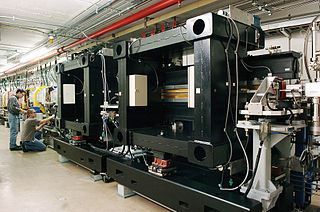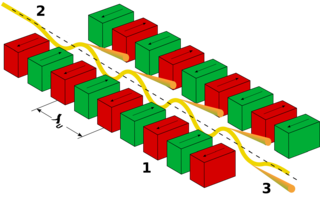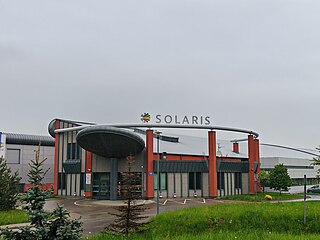
A synchrotron light source is a source of electromagnetic radiation (EM) usually produced by a storage ring, for scientific and technical purposes. First observed in synchrotrons, synchrotron light is now produced by storage rings and other specialized particle accelerators, typically accelerating electrons. Once the high-energy electron beam has been generated, it is directed into auxiliary components such as bending magnets and insertion devices in storage rings and free electron lasers. These supply the strong magnetic fields perpendicular to the beam that are needed to stimulate the high energy electrons to emit photons.

Diamond Light Source is the UK's national synchrotron light source science facility located at the Harwell Science and Innovation Campus in Oxfordshire.

An insertion device (ID) is a component in modern synchrotron light sources, so called because they are "inserted" into accelerator tracks. They are periodic magnetic structures that stimulate highly brilliant, forward-directed synchrotron radiation emission by forcing a stored charged particle beam to perform wiggles, or undulations, as they pass through the device. This motion is caused by the Lorentz force, and it is from this oscillatory motion that we get the names for the two classes of device, which are known as wigglers and undulators. As well as creating a brighter light, some insertion devices enable tuning of the light so that different frequencies can be generated for different applications.

A synchrotron is a particular type of cyclic particle accelerator, descended from the cyclotron, in which the accelerating particle beam travels around a fixed closed-loop path. The magnetic field which bends the particle beam into its closed path increases with time during the accelerating process, being synchronized to the increasing kinetic energy of the particles. The synchrotron is one of the first accelerator concepts to enable the construction of large-scale facilities, since bending, beam focusing and acceleration can be separated into different components. The most powerful modern particle accelerators use versions of the synchrotron design. The largest synchrotron-type accelerator, also the largest particle accelerator in the world, is the 27-kilometre-circumference (17 mi) Large Hadron Collider (LHC) near Geneva, Switzerland, built in 2008 by the European Organization for Nuclear Research (CERN). It can accelerate beams of protons to an energy of 7 tera electronvolts (TeV or 1012 eV).

An undulator is an insertion device from high-energy physics and usually part of a larger installation, a synchrotron storage ring, or it may be a component of a free electron laser. It consists of a periodic structure of dipole magnets. These can be permanent magnets or superconducting magnets. The static magnetic field alternates along the length of the undulator with a wavelength . Electrons traversing the periodic magnet structure are forced to undergo oscillations and thus to radiate energy. The radiation produced in an undulator is very intense and concentrated in narrow energy bands in the spectrum. It is also collimated on the orbit plane of the electrons. This radiation is guided through beamlines for experiments in various scientific areas.

A free-electron laser (FEL) is a fourth generation light source producing extremely brilliant and short pulses of radiation. An FEL functions much as a laser but employs relativistic electrons as a gain medium instead of using stimulated emission from atomic or molecular excitations. In an FEL, a bunch of electrons passes through a magnetic structure called an undulator or wiggler to generate radiation, which re-interacts with the electrons to make them emit coherently, exponentially increasing its intensity.
The National Synchrotron Light Source (NSLS) at Brookhaven National Laboratory (BNL) in Upton, New York was a national user research facility funded by the U.S. Department of Energy (DOE). Built from 1978 through 1984, and officially shut down on September 30, 2014, the NSLS was considered a second-generation synchrotron.

The Advanced Light Source (ALS) is a research facility at Lawrence Berkeley National Laboratory in Berkeley, California. One of the world's brightest sources of ultraviolet and soft x-ray light, the ALS is the first "third-generation" synchrotron light source in its energy range, providing multiple extremely bright sources of intense and coherent short-wavelength light for use in scientific experiments by researchers from around the world. It is funded by the US Department of Energy (DOE) and operated by the University of California. The current director is Dimitri Argyriou.
The Australian Synchrotron is a 3 GeV national synchrotron radiation facility located in Clayton, in the south-eastern suburbs of Melbourne, Victoria. The facility opened in 2007, and is operated by the Australian Nuclear Science and Technology Organisation.

ASTRID2 is a synchrotron light source at the Department of Physics and Astronomy of Aarhus University. ASTRID2 was designed, constructed and is operated by the Centre for Storage Ring Facilities in Aarhus (ISA).

The Swiss Light Source (SLS) is a synchrotron located at the Paul Scherrer Institute (PSI) in Switzerland for producing electromagnetic radiation of high brightness. Planning started in 1991, the project was approved in 1997, and first light from the storage ring was seen at December 15, 2000. The experimental program started in June 2001 and it is used for research in materials science, biology and chemistry.

The Synchrotron Radiation Source (SRS) at the Daresbury Laboratory in Cheshire, England was the first second-generation synchrotron radiation source to produce X-rays. The research facility provided synchrotron radiation to a large number of experimental stations and had an operating cost of approximately £20 million per annum.

The Berliner Elektronenspeicherring-Gesellschaft für Synchrotronstrahlung m. b. H., abbreviated BESSY, is a research establishment in the Adlershof district of Berlin. Founded on 5 March 1979, it currently operates one of Germany's 3rd generation synchrotron radiation facilities, BESSY II. Originally part of the Leibniz Association, BESSY now belongs to the Helmholtz-Zentrum Berlin.

A particle accelerator is a machine that uses electromagnetic fields to propel charged particles to very high speeds and energies, and to contain them in well-defined beams.
ANKA is a synchrotron light source facility at the Karlsruhe Institute of Technology (KIT). The KIT runs ANKA as a national synchrotron light source and as a large scale user facility for the international science community. Being a large scale machine of the performance category LK II of the Helmholtz Association, ANKA is part of a national and European infrastructure offering research services to scientific and commercial users for their purposes in research and development. The facility was opened to external users in 2003.
Indus-2 is a synchrotron radiation source with a nominal electron energy of 2.5 GeV and a critical wavelength of about 1.98 angstroms. It is one of the most important projects in progress at the Raja Ramanna Centre for Advanced Technology. It is designed to cater to the needs of X-ray users, material scientists and researchers. Indus-1 has the distinction of being the first synchrotron generator of India with a 450 Mev storage ring. Indus-2 is an improvement over Indus-1.
An energy recovery linac (ERL) is a type of linear particle accelerator that provides a beam of electrons used to produce x-rays by synchrotron radiation. First proposed in 1965 the idea gained interest since the early 2000s.

Herman Winick is an American scientist and Professor Emeritus at the Stanford Linear Accelerator Center (SLAC) and the Applied Physics Department of Stanford University.
The Hiroshima Synchrotron Radiation Center, also known as Hiroshima Synchrotron Orbital Radiation (HiSOR), at Hiroshima University is a national user research facility in Japan. It was founded in 1996 by the University Science Council at Hiroshima University initially as a combined educational and research facility before opening to users in Japan and across the world in 2002. It is the only synchrotron radiation experimental facility located at a national university in Japan. The HiSOR experimental hall contains two undulators that produce light in the ultraviolet to soft x-ray range. A total of 16 beamlines are supported by bending magnet and undulator radiation for use in basic studies of life sciences and physical sciences, especially solid-state physics.

SOLARIS is the only synchrotron in Central-Eastern Europe. Built in Poland in 2015, under the auspices of the Jagiellonian University, it is located on the Campus of the 600th Anniversary of the Jagiellonian University Revival, in the southern part of Kraków. It is the central facility of the National Synchrotron Radiation Centre SOLARIS.














